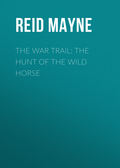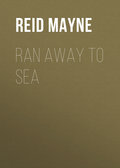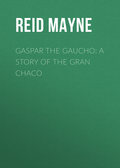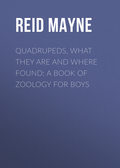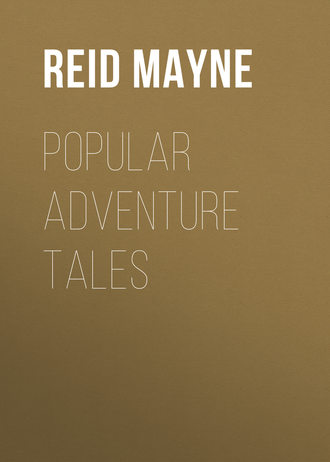
Майн Рид
Popular Adventure Tales
CHAPTER III.
THE POISON-TREES
Following the rugged and winding path, the travellers had climbed to a height of many thousand feet above the ocean level. There was very little vegetation around them. Nothing that deserved the name of tree, if we except a few stunted specimens of queñoa trees, and here and there patches of the Ratanhia shrub, which covered the hill-sides. Both these are used by the mountain Indians as fuel, but the Ratanhia is also a favourite remedy against dysentery and blood-spitting. Its extract is even exported to European countries, and is to be found in the shop of the apothecary.
Now and then a beautiful species of locust was seen with its bright red flowers. It was the “Sangre de Christo” of the Peruvian flora.
Don Pablo Romero was a naturalist, and I may here tell you a pleasant and interesting fact – which is, that many of the earliest patriots and revolutionists of Spanish America were men who had distinguished themselves in natural science – in fact, were the “savans” of these countries. I call this a pleasant fact, and you may deem it a curious one too, because men of science are usually lovers of peace, and not accustomed to meddle either in war or politics.
But the truth of the matter is this, – under the government of the viceroys all books, except those of a monkish religion, were jealously excluded from these countries. No political work whatever was permitted to be introduced; and the people were kept in the grossest ignorance of their natural rights. It was only into learned institutions that a glimmering of the light of freedom found its way, and it was amongst the professors of these institutions that the “rights of men” first began to be discussed. Many of these noble patriots were the first victims offered up on the altar of Spanish-American independence.
Don Pablo, I have said, was a naturalist; and it was perhaps the first journey he had ever made without observing attentively the natural objects that presented themselves along his route. But his mind was busy with other cares; and he heeded neither the fauna nor flora. He thought only of his loved wife and dear children, of the dangers to which he and they were exposed. He thought only of increasing the distance between them and his vengeful enemies. During that day they had made a toilsome journey of fifteen miles, up the mountain – a long journey for the llamas, who rarely travel more than ten or twelve; but the dumb brutes seemed to exert themselves as if they knew that danger threatened those who guided them.
They belonged to Guapo, who had not been a mere servant, but a cultivator, and had held a small “chacra,” or farm, under Don Pablo. Guapo's voice was well known to the creatures, and his “hist!” of encouragement urged them on. But fifteen miles was an unusual journey, and the animals began to show symptoms of fatigue. Their humming noise, which bears some resemblance to the tones of an Eolian harp, boomed loud at intervals as the creatures came to a stop; and then the voice of Guapo could be heard urging them forward.
The road led up a defile, which was nothing more than the bed of a mountain-torrent, now dry. For a long distance there was no spot of level ground where our travellers could have encamped, even had they desired to stop. At length, however, the path led out of the torrent-bed, and they found themselves on a small ledge, or table, covered with low trees. These trees were of a peculiar kind, very common in all parts of the Andes, and known as mollé trees. They are more properly bushes than trees, being only about ten or twelve feet in height. They have long delicate pinnate leaves, very like those of the acacia, and, when in fruit, they are thickly covered with clusters of small bright red berries.
These berries are used among some tribes of Indians for making a highly valuable and medicinal beer; but the wood of the tree is of more importance to the people of those parts as an article of fuel, because the tree grows where other wood is scarce. It is even considered by the sugar-refiners as the best for their purpose, since its ashes, possessing highly alkaline properties, are more efficient than any other in purifying the boiling juice of the sugar-cane. The leaves of this beautiful tree, when pressed, emit a strong aromatic smell; and a very curious property ascribed to it by the more ignorant people of the mountains will be illustrated by the dialogue which follows: —
“Let us pass the night here,” said Don Pablo, halting, and addressing himself to Guapo. “This level spot will serve us to encamp. We can sleep under the shade of the bushes.”
“What! mi amo! (my master) Here?” replied the Indian, with a gesture of surprise.
“And why not here? Can any place be better? If we again enter the defile we may find no other level spot. See! the llamas will go no farther. We must remain therefore.”
“But, master,” continued Guapo – “see!”
“See what?”
“The trees, master!”
“Well, what of the trees? Their shade will serve to screen us from the night dew. We can sleep under them.”
“Impossible, master —they are poison trees!”
“You are talking foolishly, Guapo. These are mollé trees.”
“I know it, señor; but they are poison. If we sleep under them we shall not awake in the morning – we shall awake no more.”
And Guapo, as he uttered these words, looked horrified.
“This is nonsense; you are superstitious, old man. We must abide here. See, the llamas have lain down. They will not move hence, I warrant.”
Guapo turned to the llamas, and thinking that their movements might influence the decision of his master, began to urge them in his accustomed way. But it is a peculiarity of these creatures not to stir one step beyond what they consider a proper journey. Even when the load is above that which they are accustomed to carry – that is to say, 120 lbs. – neither voice nor whip will move them. They may be goaded to death, but will not yield, and coaxing has a like effect. Both knew that they had done their day's work; and the voice, the gesticulations and blows of Guapo, were all in vain. Neither would obey him any longer. The Indian saw this, and reluctantly consented to remain; at the same time he continued to repeat his belief that they would all most certainly perish in the night. For himself, he expressed his intention to climb a ledge, and sleep upon the naked rocks; and he earnestly entreated the others to follow his example.
Don Pablo listened to the admonitions of his retainer with incredulity, though not with any degree of disdain. He knew the devotedness of the old Indian, and therefore treated, what he considered a mere superstition, with a show of respect. But he felt an inclination to cure Guapo of the folly of such a belief; and was, on this account, the more inclined to put his original design into execution. To pass the night under the shade of the mollé trees was, therefore, determined upon.
All dismounted. The llamas were unloaded; their packs, or yerguas, taken off; the horse and mule were unsaddled; and all were permitted to browse over the little space which the ledge afforded. They were all trained animals. There was no fear of any of them straying.
The next thing was to prepare supper. All were hungry, as none of the party had eaten since morning. In the hurry of flight, they had made no provision for an extended journey. A few pieces of charqui (jerked or dried beef) had been brought along; and, in passing near a field of “oca,” Guapo had gathered a bunch of the roots, and placed them on the back of his llama. This oca is a tuberous root, of an oval shape and pale red colour, but white inside. It resembles very much the Jerusalem artichoke, but it is longer and slimmer. Its taste is very agreeable and sweetish – somewhat like that of pumpkins, and it is equally good when roasted or boiled.
There is another sort of tuberous root, called “ulluca” by the Peruvians, which is more glutinous and less pleasant to the taste. This kind is various in form, being either round, oblong, straight, or curved, and of a reddish, yellow colour outside, though green within. It is insipid when boiled with water, but excellent when dressed with Spanish peppers (Capsicum). Out of the oca, then, and charqui, the supper must be made; and for the purpose of cooking it, a fire must be kindled with the wood of the mollé.
For a long time there was a doubt about whether it would be safe to kindle this fire. The sun had not yet gone down, and the smoke might attract observation from the valley below. If the pursuers were on their track, it might be noticed; as upon this lonely route a fire would indicate nothing else than the camp of some one on a journey. But the stomachs of our travellers cried for food, and it was at length resolved to light the fire, but not until after sunset, when the smoke could be no longer seen, and the blaze would be hidden behind the thick bushes of mollé.
Don Pablo walked off from the camp, and wandered among the trees to see if he could find something that might contribute a little variety to their simple supper. A small, broom-like plant, that grew among the mollé trees, soon attracted his attention. This was the quinoa plant, which produces a seed, not unlike rice, though smaller in the grain, whence it has received in commerce the name “petty rice.” The quinoa seeds, when boiled, are both pleasant and nutritious, but especially so when boiled in milk. Previous to the discovery of America, “quinoa” was an article of food, supplying the place of wheat. It was much used by the natives, and is still collected for food in many parts. Indeed, it has been introduced into some European countries, and cultivated with success. The leaves, when young, can be used as spinach, but the seeds are the most sought after for food.
Don Pablo having called Leon to assist him, a quantity of the seeds were soon collected into a vessel, and carried to the place which they had chosen for their camp; and, as it was now dark enough, the fire was kindled and the cooking-pot got ready. The Doña Isidora, although a fine lady, was one of those who had all her life been accustomed to look after her household affairs; and this, it may be remarked, is a somewhat rare virtue among the Peruvian ladies, who are generally too much given to dress and idleness. It was not so, however, with the wife of Don Pablo. She knew how to look after the affairs of the cuisine, and could dress any of the peculiar dishes of the country with the best of cooks. In a short while, therefore, an excellent supper was ready, of which all ate heartily, and then, wrapping themselves up in their ponchos, lay down to sleep.
CHAPTER IV.
THE SUPPER OF GUAPO
I have said all ate of the supper. This is not strictly true. One of the party did not touch it, and that was old Guapo. Why? Was he not hungry like the rest? Yes; as hungry as any of them. Why then did he not eat of the charqui and ocas? Simply because Guapo had a supper of a very different kind, which he carried in his pouch, and which he liked much better than the charqui stew. What was it? It was “coca.”
“Chocolate,” you will say, or, as some call it, “cocoa,” which should be called, to name it properly, “cacao.” No, I answer – it was not chocolate, nor cocoa, nor cacao neither.
“It must have been cocoa-nuts then?” No; nor yet cocoa-nuts. The “coca,” upon which Guapo made his supper, and which contented his stomach perfectly for the night, was an article very different from either the cacao which makes chocolate, or the nut of the cocoa-palm. You are now impatient to hear what sort of thing it was, and I shall tell you at once.
The coca is a small tree or shrub about six feet in height, which grows in the warmer valleys among the Andes mountains. Its botanical name is Erythroxylon coca. Its leaves are small and of a bright green colour, and its blossoms white. Its fruits are very small scarlet berries. It is a native plant, and, therefore, found in a wild state; but it is cultivated by the planters of these countries in fields regularly laid out, and hence called “cocales.” This plant is raised from the seed, and when the young shoots have attained the height of about eighteen inches, they are transplanted and put down again at the distance of about a foot apart from each other.
Now as these little bushes require a humid atmosphere, maize-plants are sown between the rows to protect them from the sun. In other places arbours of palm-leaves are constructed over the coca-plants. When no rain falls, they are watered every five or six days. After about two and a half years of this nursing, the coca-bush is ready for use, and it is the leaves alone that are valuable. These are gathered with great care, just as the Chinese gather the leaves of the tea-plant; and, as in China, women are principally employed in this labour. The leaves are said to be ripe, not when they have withered and turned brown, but at a period when they are full-grown and become brittle. When this period arrives, they are picked from the tree, and laid out on coarse woollen cloths to dry in the sun.
When dried, they remain of a pale green colour; but should they get damp during the process, they become darker, and are then of inferior quality, and sell for a less price. When fully dried, they are carefully packed in bags and covered up with dry sand, and are thus ready for the market. Their price, on the spot where the crop is produced, is about one shilling English per pound. They are, therefore, full as costly to produce as tea itself, although the coca-bush will yield three crops of leaves in one year – that is, a crop every four months; and one hundred plants will produce about an arroba (25 lbs.) at a crop. The coca-plant will continue to give fresh leaves for a long period of years, unless attacked and destroyed by ants, which is not unfrequently the case.
Now, why have I so minutely described the coca-bush? Because, that, in the economy of the life of those Indians who inhabit the countries of the Andes mountains, this curious plant plays a most important part. Scarcely one of these people is to be met with who is not an eater of cocoa – a “coquero.” With them it is what the tea-tree is to the Chinese. Indeed, it is a curious fact, that in all parts of the world some stimulating vegetable is used by the human race. Tea in China; the betel-leaf, and the nut of the areca palm, among the Southern Asiatics; the poppy in the East; with tobacco, and many like things, in other countries.
But the coca not only supplies the Indian with a solace to his cares, it forms the chief article of his food. With a supply of coca, an Indian will support himself five or six days without eating anything else. The poor miners, in the Peruvian mines, are all “coqueros;” and it is alleged that, without coca, they would be unable to undergo the painful toil to which their calling subjects them. When used to excess, the coca produces deleterious effects on the human system; but, if moderately taken, it is far more innocent in its results than either opium or tobacco.
The coca-leaf is not eaten alone. A certain preparation is necessary, and another substance is mixed with it before it produces the proper effect. But let us watch the movements of Guapo, and we shall see how he does it, for Guapo is a confirmed coquero.
Guapo, true to his promise, does not sleep under the mollé trees. He leaves the party, and, with a melancholy air, has climbed up and seated himself upon a projecting rock, where he intends to pass the night. His last glance at Don Pablo and his family was one of foreboding. He had again remonstrated with his master, but to no purpose. The latter only laughed at the earnestness of the old Indian, and told him to go to his perch and leave the party to themselves.
It was still grey light when Guapo climbed up to the rock. Against the sky his tall, lank form could be traced in all its outlines. For some moments he sat in a serious and reflective mood – evidently busy with thoughts about the “poison-trees.” His appetite, however, soon got the better of him; and he set to work to prepare his coca supper. It was a simple operation.
Around Guapo's neck there hung a small pouch made of the skin of the chinchilla, which beautiful little animal is a native of these parts. This pouch contained a quantity of the dry leaves of the coca. Having taken out some half-dozen of these leaves, he put them into his mouth and commenced chewing them. In a short while, by the aid of tongue, teeth, and lips, they were formed into a little ball of pulp, that rolled about in his mouth. Another step in the process now became necessary. A small gourd, that hung around Guapo's neck by a thong, was laid hold of. This was corked with a wooden stopper, in which stopper a wire pin was fixed, long enough to reach down to the bottom of the gourd.
After taking out the stopper, Guapo applied the lower part of the pin to his lips, and then, plunging it once more into the gourd, drew it out again. This time the pin came out, with a fine whitish powder adhering to the part that had been wetted. Now what was this powder? It was nothing else than lime that had been burned, and pulverised. Perhaps it was the ashes of the mollé tree, of which we have already spoken, and which, as we have said, possess a highly alkaline property. The ashes of the musa, or plaintain, are sometimes used; but, after all, it is most likely that it was the mollé ashes which Guapo carried, for these are most highly esteemed by the Indians of Southern Peru; and Guapo was a connoisseur in coca-eating.
Whichever of the three it was – lime, mollé, or musa – Guapo carried the pin to his mouth, and, without touching his lips (it would have burnt him if he had), he inserted it, so as to penetrate the ball of chewed cocoa-leaves that rested upon the tip of his tongue. This was stabbed repeatedly and adroitly by the pin, until all the powder remained in the coca-ball; and then the pin was withdrawn, wiped, and restored to its place, along with the stopper of the gourd.
Guapo now remained quietly “ruminating” for a period of about forty minutes – for this is about the time required for chewing a mess of cocoa-leaves. Indeed, so exactly is this time observed, that the Indians, when travelling, measure distances by it; and one “coceada” is about equal to the time occupied in walking a couple of English miles.
The coceada of our old Indian being finished, he drew his llama-wool poncho around him; and, leaning back against the rock, was soon buried in a profound slumber.
CHAPTER V.
THE PUNA
By early dawn Guapo was awake, but he did not immediately awake the others. It was still too dark to follow the mountain road. His first care was to have his coca breakfast, and to this he applied himself at once.
Day was fairly broke when he had ended the process of mastication, and he bethought him of descending from the rock to arouse the sleepers. He knew they still slept, as no voice had yet issued from the grove of mollés. The mule and horse were heard cropping the grass, and the llamas were now feeding upon an open spot, – the first they had eaten since their halt, as these creatures do not browse in the night.
Guapo descended with fear in his heart. How it would have joyed him to hear the voice of his master, or of any of them! But, no. Not a sound proceeded from any one of the party. He stole nimbly along the ledge, making his way through the mollé trees. At length he reached the spot. All asleep? – yes, all! “Are they dead?” thought Guapo, and his heart beat with anxiety. Indeed, they seemed so. The fatigue of travel had cast a sickly paleness over the faces of all, and one might easily have fancied they no longer lived. But they breathed. “Yes, they breathe!” ejaculated the old Indian, half aloud. “They live!”
Guapo bent down, and seizing Don Pablo by the arm, shook him – at first gently, uttering, at the same time, some words to awake him. But neither the shaking nor the voice had any effect. Guapo shook more violently, and shouted louder. Still Don Pablo slept. None of the others moved – none of them heard him. It was strange, for the Indian knew that Don Pablo himself, as well as the others, were easily awaked on ordinary occasions. Guapo, becoming alarmed, now raised his voice to its loudest pitch, at the same time dragging Don Pablo's shoulder in a still more violent manner. This had the desired effect. The sleeper awoke but so slowly, and evidently with such exertion, that there was something mysterious in it.
“What is it?” he inquired, with half-opened eyes. “Is it morning already?”
“The sun is up. Rouse, my master! It is time we were on the road,” replied the Indian.
“I feel very drowsy – I am heavy – I can scarce keep my eyes open. What can be the cause of this?”
“The poison-trees, master,” answered Guapo.
The answer seemed to impress Don Pablo. He made a violent effort, and rose to his feet. When up he could scarcely stand. He felt as though he had swallowed a powerful opiate.
“It must be so, good Guapo. Perhaps there is some truth in what you have said. O, heavens!” exclaimed he, suddenly recollecting himself, – “the others – my wife and children!”
This thought had fully awakened Don Pablo; and Guapo and he proceeded at once to arouse the others, which they effected after much shouting and shaking. All were still heavy with sleep, and felt as did Don Pablo himself.
“Surely there is some narcotic power in the aroma of these trees,” muttered Don Pablo. “Come, wife, let us be gone! We must remain under its influence no longer, else what Guapo has said may prove too true. Saddle up – we must eat our breakfasts farther on. To the road! – to the road!”
Guapo soon had the horses ready, and all hurried from the spot, and were once more climbing up the mountain-path. Even the animals seemed to move slowly and lazily, as though they, too, had been under the influence of some soporific. But the pure cold air of the mountain soon produced its effect. All gradually recovered, and after cooking some charqui and ocas in the ravine, and making their breakfast upon these, they again felt light and fresh, and pursued their journey with renewed vigour.
The road kept on up the ravine, and in some places the banks rose almost perpendicularly from the bed of the dry torrent, presenting on both sides vast walls of black porphyry – for this is the principal rock composing the giant chain of the Andes. Above their heads screamed small parrots of rich plumage of the species Conurus rupicola, which make their nestling places, and dwell upon these rocky cliffs. This is a singular fact, as all other parrots known are dwellers among trees and are found in the forest at all times, except when on their passage from place to place.
But even the squirrel, which is an animal peculiarly delighting in tree-life, has its representative in several species of ground-squirrels, that never ascend a tree; and, among the monkeys, there exists the troglodyte or cave-dwelling chimpanzee. No doubt squirrels or monkeys of any kind, transported to an open or treeless country, would soon habituate themselves to their new situation, – for Nature affords many illustrations of this power of adaptation on the part of her creatures.
It was near sunset when our travellers reached the highest point of their route, nearly 14,000 feet above the level of the sea! Here they emerged upon an open plain which stretched far before them. Above this plain towered mountains of all shapes to a height of many thousand feet from the level of the plain itself. Some of these mountains carried their covering of eternal snow, which, as the evening sun glanced upon it, exhibited the most beautiful tints of rose, and purple, and gold. The plain looked bleak and barren, and the cold which our travellers now felt added to the desolateness of the scene. No trees were in sight. Dry yellow grass covered the ground, and the rocks stood out naked and shaggy. They had reached one of those elevated tables of the Andes known as the Puna.
These singular tracts elevated above the level of cultivation are almost uninhabited. Their only inhabitants are a few poor Indians, who are employed by the rich proprietors of the lower valleys as shepherds; for upon these cold uplands thrive sheep, and cattle, and llamas, and flocks of the wool-bearing alpaco. Through this wild region, however, you may travel for days without encountering even a single one of the wretched and isolated inhabitants who watch over these flocks and herds.
On reaching the Puna, our party had made their day's journey, and would have halted. The llamas already showed signs of giving out by stopping and uttering their strange booming note. But Guapo knew these parts – for, though a descendant of the Incas, he had originally come from the great forest beyond the eastern slope of the Andes, where many of the Peruvian Indians had retired after the cruel massacres of Pizarro. He now remembered, that not far from where they were, was a shepherd's hut, and that the shepherd himself was an old friend of his. That would be the place to stop for the night; and, by Guapo's advice, Don Pablo resolved to continue on to the hut.
Guapo fell upon his knees before the llamas, and, after caressing and kissing them, and using a great variety of endearing expressions, he at last coaxed these animals to proceed. No other means would have availed, as beating would not make either llama budge an inch. The leader, who was a fine large animal and a great favourite with its master, at length stepped boldly out; and the other, encouraged by the sound of the small bells that tinkled around the head of the leader, followed after, and so the travellers moved on.
“Come, papa!” cried Leon; “you are tired yourself – mount this horse – I can walk a bit:” at the same instant the boy flung himself from the back of the horse, and led him up to where his father stood. Then handing the bridle to the latter, he struck off along the plain, following Guapo and his llamas.
The road skirted round the rocks, where the mountain came down to meet the plain. The walk was not a long one, for the hut of which Guapo spoke became visible at less than a quarter of a mile's distance. An odd-looking hut it was – more like an ill-built stack of bean-straw than a house. It had been built in the following manner: —
First, a round ring of large stones had been laid, then a row of turf, then another tier of stones, and so on, until the circular wall had reached the height of about four or five feet, the diameter being not more than eight or nine. On the top of the wall a number of poles had been set, so as to meet above where they were tied together. These poles were nothing else than the long flower-stalks of the maguey or American aloe, as no other wood of sufficient length grew in the vicinity. These poles served for rafters, and across them laths had been laid, and made fast. Over all this was placed a thatch of the long coarse Puna grass, which was tied in its place by grass ropes that were stretched from side to side over the top. This was the hut of Guapo's friend, and similar to all others that may be encountered in the wild region of the Puna. A door was left in the side, not over two feet high, so that it was necessary to crawl upon the hands and knees before any one could reach the interior.
As our travellers approached, they saw that the entrance was closed by an ox-hide which covered the whole of the opening.
Whether the shepherd was at home, was the next question; but as they got near to the house, Guapo suggested that Don Pablo should dismount and let Leon get upon horseback. This suggestion was made on account of the Puna dogs – of which creatures Guapo had a previous knowledge. These dogs, known by the name of Inca dogs, are, perhaps, the fiercest animals of their species.
They are small, with pointed muzzles, tails curling upward, and long shaggy hair. They are half-wild, snappish, and surly, as it is possible for dogs to be. They attack strangers with fury, and it is as much as their masters can do to rescue even a friend from their attack. Even when wounded, and unable any longer to keep their feet, they will crawl along the ground and bite the legs of those who have wounded them. They are even more hostile to white people than to Indians, and it is sometimes dangerous to approach an Indian hut where three or four of these fierce creatures are kept, as they will jump up against the side of a horse, and bite the legs of the rider. Their masters often use the stick before they can get obedience from them. In every Indian hut several of these animals may be found, as they are extremely useful to the shepherds in guarding their flocks and for hunting.
They are much employed throughout the Puna to hunt the “yutu,” a species of partridge which inhabits the rushy grass. This bird is traced by the dogs, seized before it can take to flight, and killed by a single bite of its fierce pursuer. Considering the savage nature of the Inca dogs, Guapo showed great caution in approaching the hut of his friend. He first called loudly, but there was no reply. He then stole forward with his long knife, or “macheté,” in his hand; and having lifted the skin that covered the low doorway, peeped in. The hut was empty.



